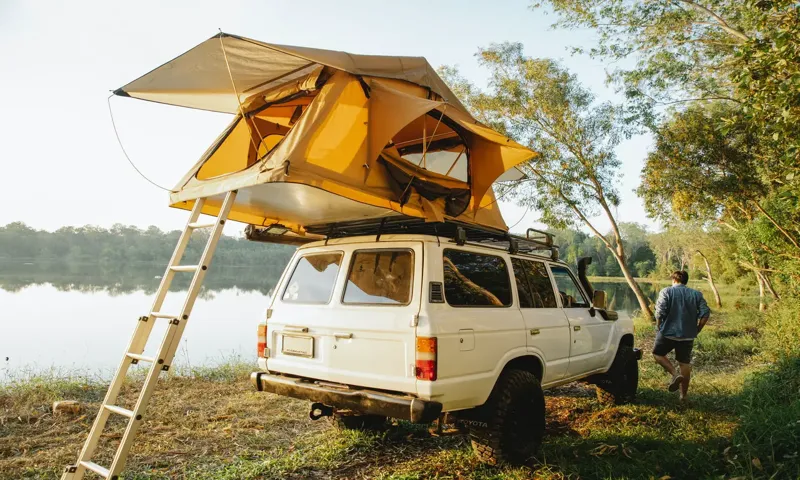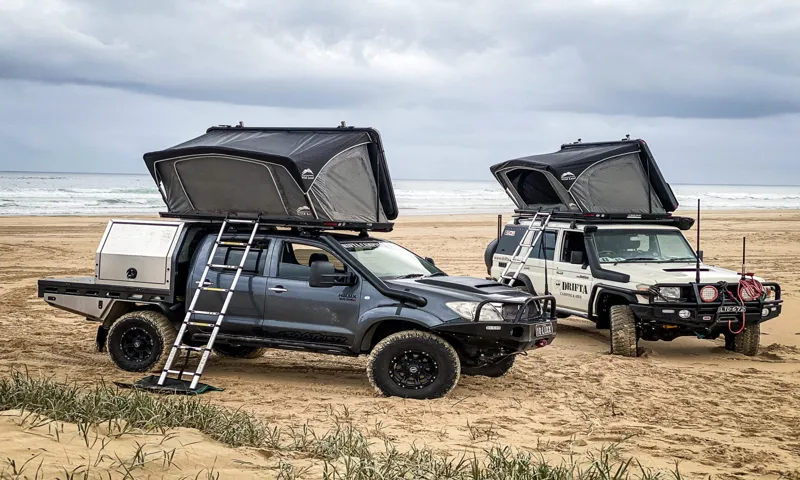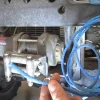Imagine camping on a beautiful summer night, surrounded by nature’s serenity. You set up your roof top tent, excited for a restful night under the stars. But as the temperature rises, you quickly realize that staying cool in your tent is going to be a challenge.
The sun beats down on your shelter, turning it into a sweltering oven. How do you keep cool in this situation?
Table of Contents
Understanding the Heat: The Impact of the Sun’s Rays
When it comes to camping in a roof top tent, staying cool in the heat can be a challenge. The sun’s rays can really heat up the tent, making it uncomfortable to sleep or relax inside. But don’t worry, there are a few things you can do to beat the heat and stay cool.
First, choose a shady spot to set up your tent if possible. This will provide natural shade and help to keep the inside cooler. You can also use reflective tarps or blankets to cover the tent, which will reflect the sun’s rays and keep the temperature down.
Another trick is to use a portable fan inside the tent. This will circulate the air and create a cooling breeze. Lastly, make sure to stay hydrated and wear lightweight, breathable clothing.
This will help to regulate your body temperature and keep you cool throughout the day. So don’t let the heat get in the way of a great camping experience – follow these tips and stay cool in your roof top tent.
The intensity of the sun’s rays on a rooftop
One of the most impactful elements of the sun’s rays is their intensity, especially on a rooftop. When the sun shines down on a rooftop, the intensity of its rays can be quite powerful. This is because the rooftop is directly exposed to the sun’s rays without any obstructions, allowing them to hit the surface with full force.
Imagine standing under a hot shower and feeling the water hit your skin. That’s similar to what happens when the sun’s rays hit a rooftop. The heat can be so intense that it can be felt even from a distance.
That’s why it’s important to understand the impact of the sun’s rays on a rooftop, as they can greatly affect the overall temperature of a building. The intensity of the sun’s rays on a rooftop can lead to a significant increase in temperature inside the building, making it uncomfortable and even unbearable at times. This is where proper insulation and ventilation come into play, as they can help regulate the temperature and make the building more energy-efficient.
So, the next time you’re on a rooftop, take a moment to appreciate the power of the sun’s rays and their impact on the surrounding environment.

Effects of heat buildup inside a roof top tent
roof top tent, heat buildup, sun’s rays Do you love camping and have a roof top tent? It’s a great way to enjoy the outdoors and sleep comfortably, but have you ever wondered about the heat buildup inside your tent? Understanding the impact of the sun’s rays can help you stay cool and comfortable during your camping trips. When the sun’s rays hit your roof top tent, they can create a greenhouse effect, trapping heat inside. This can quickly turn your tent into a sauna, making it uncomfortable to sleep or relax.
The heat buildup can also damage your tent over time, causing the fabric to deteriorate and the zippers to become stuck. To combat this, it’s important to take proactive measures to keep your tent cool. This could include using reflective materials to block the sun’s rays, installing ventilation fans, or choosing a shady camping spot.
By understanding the impact of the sun’s rays and taking steps to mitigate heat buildup, you can ensure that your roof top tent remains a comfortable and enjoyable camping experience.
Choosing the Right Location
When it comes to staying cool in a roof top tent, choosing the right location can make all the difference. Look for shaded areas with natural airflow, such as under trees or near bodies of water. These spots can help lower the ambient temperature and provide a cool breeze.
Additionally, consider the aspect and elevation of the location. A higher elevation can offer cooler temperatures, while a southern-facing spot may get more sun exposure and heat. It’s also important to avoid parking in direct sunlight, especially during the peak heat of the day.
If possible, try to park the vehicle in a way that provides shade to the tent throughout the day. Lastly, don’t forget about the insulating properties of the tent itself. Look for tents with good ventilation and materials that help regulate temperature, such as UV-resistant fabric or reflective coatings.
By considering these factors, you can create a more comfortable and cool environment in your roof top tent. So, let’s go camping and stay cool!
Finding shaded areas to park your vehicle
Finding shaded areas to park your vehicle can be a real challenge, especially on hot summer days. But choosing the right location can make all the difference in keeping your vehicle cool and protected from the harsh sun. One option is to look for parking spots under trees.
Not only do trees provide shade, but they also help to lower the temperature in their vicinity through a process called evapotranspiration. Another option is to find parking garages or structures that offer covered parking. These structures are designed to provide shade and protection for vehicles, making them a great choice on sunny days.
Lastly, if you’re unable to find a shaded spot, you can invest in car shades or window visors to help block out the sun’s rays. These accessories are easy to install and can make a significant difference in keeping your vehicle cool. By selecting the right location and taking some additional measures, you can help protect your vehicle from the heat and sun damage.
So next time you’re looking for a parking spot, keep these tips in mind to find the perfect shaded area for your vehicle.
Considering the direction of the sun
When it comes to choosing the right location for your outdoor activities, considering the direction of the sun is crucial. The position of the sun can have a significant impact on the comfort and enjoyment of your outdoor space. For example, if you are planning to have a patio or seating area, you’ll want to choose a location that gets plenty of sunlight, especially during the cooler months.
The sun’s rays can provide warmth and make your outdoor space more inviting. On the other hand, if you are planning to have a garden or a pool, you’ll want to consider the direction of the sun to ensure that the plants or pool are not constantly in the shade. Plants need sunlight to grow, and a pool that is constantly in the shade may not be as enjoyable to swim in.
So, before you decide on a location for your outdoor activities, take some time to observe the sun’s path throughout the day and choose a spot that will make the most of the sun’s rays.
Setting Up Your Tent for Optimal Airflow
When it comes to staying cool in a rooftop tent, setting up your tent for optimal airflow is key. One way to achieve this is by choosing a tent with plenty of windows or vents that can be opened to allow for cross ventilation. Positioning your tent in a shady area can also help to keep the interior temperature down.
Another tip is to use a reflective tarp or shade cloth to cover your tent, which can help to reflect the sun’s rays and keep the inside cool. Additionally, using a portable fan or battery-operated fan inside the tent can greatly improve airflow and make for a more comfortable sleeping environment. Don’t forget to pack a few extra sleeping bag liners or blankets that are made of breathable fabric, as these can also help to regulate body temperature during hot nights.
By following these tips, you can ensure that you stay cool and comfortable during your next rooftop camping adventure.
Using rooftop tent ventilation features
ventilation features, rooftop tent, optimal airflow, setting up tent When it comes to camping in a rooftop tent, one of the most important considerations is ensuring good ventilation. After all, you don’t want to spend your sleeping hours feeling suffocated and hot inside your tent. That’s where the ventilation features come into play.
These features are designed to help maintain a steady air flow, keeping the temperature inside the tent comfortable throughout the night. So, how can you set up your rooftop tent for optimal airflow? First and foremost, make sure to open all the vents and windows. This will allow fresh air to enter the tent while letting hot air escape.
You can also invest in a tent with a mesh ceiling, which will help in increasing air circulation. Another tip is to position your tent in a way that takes advantage of natural breezes. Place it in a location where the wind can easily pass through the tent, such as near a tree line or on the edge of a hill.
Lastly, don’t forget to use any additional airflow accessories that may come with your tent, such as fan brackets or air vents. By following these tips, you can create a comfortable and well-ventilated sleeping environment in your rooftop tent. So, hit the road, set up your tent, and enjoy a good night’s sleep under the stars.
Positioning the tent to catch cross breezes
tent, airflow, positioning, cross breezes Setting up your tent in the right location can make a huge difference in your camping experience, especially when it comes to catching those refreshing cross breezes. One of the first things to consider is the direction the wind is coming from. If possible, try to position your tent so that the entrance is facing into the wind.
This way, when you unzip the door, the breeze will naturally flow into your tent, providing a much-needed escape from the heat. Additionally, peek around for any nearby obstacles that could block the airflow, such as trees or high-growing bushes. By finding a spot that is open and allows for a clear path of air, you’ll maximize the cooling effect.
Keep in mind that the position of the sun can also impact the airflow in your tent. If you’re camping during the summer, try to find a spot that offers shade during the hottest parts of the day. This will help keep your tent cooler and less stuffy.
Remember, a well-ventilated tent is not only more comfortable but can also help prevent condensation and reduce the chance of musty odors. So take a few extra minutes to set up your tent in a prime location, and you’ll be rewarded with a refreshing breeze throughout your camping trip.
Using reflective materials to reduce heat absorption
tent, airflow, reflective materials, heat absorption
Cooling Strategies Inside the Tent
Staying cool inside a rooftop tent can sometimes be a challenge, especially in hot summer months. Thankfully, there are a few strategies you can employ to beat the heat and enjoy a comfortable night’s sleep. One option is to invest in a tent with built-in ventilation or windows that can be opened to allow for airflow.
Another strategy is to use a portable fan or battery-operated cooling system inside the tent. These can help circulate air and provide a much-needed breeze. Additionally, you can try using reflective blankets or tarps on the outside of the tent to deflect sunlight and keep the interior cooler.
Lastly, be mindful of the location where you set up your rooftop tent. Choose shaded areas or campsites with natural ventilation to maximize comfort. With these cooling strategies in place, you’ll be able to relax and enjoy your camping experience, even in the hottest of weather.
Using portable fans and air circulation devices
portable fans, air circulation devices, cooling strategies, inside the tent Are you looking for ways to stay cool inside your tent during those hot summer camping trips? Well, look no further because we have some great cooling strategies for you! One of the most effective ways to beat the heat is by using portable fans and air circulation devices. These handy little gadgets can help create a gentle breeze inside your tent, making it feel much cooler and more comfortable. Plus, they are small and lightweight, making them easy to transport and set up wherever you need them.
Whether you’re camping in a tent or a camper van, these cooling devices are a must-have for hot summer nights. So, don’t let the heat ruin your camping experience. Invest in a portable fan or air circulation device and keep cool inside your tent all summer long!
Using evaporative cooling methods
evaporative cooling methods, cooling strategies inside the tent
Keeping the tent fabric and bedding cool
Keeping the tent fabric and bedding cool is essential for a comfortable camping experience, especially during hot summer months. Thankfully, there are several strategies you can employ to beat the heat inside your tent. One effective method is to choose a tent with good ventilation.
Look for tents with multiple mesh windows and a large mesh ceiling, as these features will allow for maximum airflow. Another option is to set up your tent in a shaded area, away from direct sunlight. This will help to prevent the fabric and bedding from absorbing excessive heat.
Additionally, consider using a reflective tarp or a tent fly to cover your tent. These materials can help to deflect sunlight and keep the interior cooler. And, of course, using a portable fan or battery-powered air conditioner can make a world of difference in keeping your tent cool.
Just be sure to place the fan strategically for optimal airflow. Incorporating these strategies into your camping routine will ensure a much more comfortable, cool, and enjoyable experience in your tent.
Nighttime Cooling Tips
Sleeping in a roof top tent can be an amazing experience, but it can also be a challenge to stay cool on those hot summer nights. Thankfully, there are a few simple tricks you can use to beat the heat and get a good night’s sleep. First, it’s important to choose a shady spot to set up your tent if possible.
This will help to keep the direct sunlight off of your tent during the day and keep it cooler at night. If finding shade is not an option, you can also use a reflective tarp or blanket to cover your tent during the day to help deflect the sun’s rays. Another tip is to make use of natural ventilation.
Open up the windows and vents on your roof top tent to allow for cross ventilation, which will help to keep air flowing through the tent and cool you down. Additionally, you can bring a portable fan or battery-operated cooling device to help circulate air inside the tent. Finally, dressing in lightweight and breathable clothing and using a cooling pillow or mattress can also make a big difference in staying cool throughout the night.
So, with these tips in mind, you’ll be able to beat the heat and enjoy a comfortable night’s sleep in your roof top tent.
Utilizing natural ventilation at night
nighttime cooling
Choosing the right bedding materials for heat dissipation
Choosing the right bedding materials for heat dissipation can make a big difference in how comfortable you feel during the night. When the weather is hot, it’s important to choose materials that allow for proper airflow and heat dissipation. One option is cotton, which is known for its breathability and ability to wick away moisture.
Another option is bamboo, which is not only eco-friendly but also has natural cooling properties. Bamboo bedding can help regulate your body temperature and keep you cool throughout the night. Additionally, consider using a mattress pad or topper that is specifically designed for heat dissipation.
These are often made with materials such as gel-infused foams or latex, which can help regulate body heat and provide a cooler sleep surface. So, if you find yourself tossing and turning at night due to the heat, consider investing in bedding materials that will help you stay cool and comfortable.
Using cooling accessories like gel pillows or cooling mats
One effective way to stay cool during the night is to use cooling accessories such as gel pillows or cooling mats. These accessories are designed to regulate your body temperature and provide a comfortable sleep environment. Gel pillows are filled with a cooling gel that absorbs and dissipates heat, keeping your head and neck cool throughout the night.
Cooling mats work by using a combination of cooling gel and airflow technology, providing a refreshing sensation to your body as you sleep. These accessories can be a great addition to your bedtime routine, especially during hot summer nights or for those who tend to sleep hot. So, if you’re finding it difficult to stay cool and comfortable during the night, why not give these cooling accessories a try? They may just be the solution you’ve been looking for.
Conclusion: Staying Cool and Comfortable in Your Roof Top Tent
In conclusion, staying cool in a rooftop tent requires a combination of resourcefulness, adaptability, and a touch of ingenuity. By following these clever tips and tricks, you’ll be able to beat the heat and keep your sanity intact while sleeping in your lofty abode. Remember to choose a well-ventilated tent, preferably one with multiple windows or a mesh ceiling to promote optimal airflow.
Utilize reflective tarps or blankets to block out the sun’s scorching rays, creating a shady oasis within your rooftop fortress. To maximize airflow, strategically position your tent to catch any favorable breezes and invest in a portable fan or two to keep the air circulating. Channel your inner MacGyver and experiment with homemade cooling inventions, like a DIY evaporative cooler or a solar-powered fan, to provide some much-needed relief.
Embrace the power of technology and equip yourself with cooling gadgets such as a portable air conditioner or a cooling mat. These modern marvels will make you the envy of all other rooftop campers, as you blissfully bask in a cool and comfortable slumber. And if all else fails, why not indulge in a little rooftop glamping? Transform your tent into a luxurious oasis by hanging fairy lights for ambiance, setting up a mini bar complete with ice-cold beverages, and investing in a plush memory foam mattress to ensure your dreams are nothing short of heavenly.
So, whether you’re traversing the sweltering desert or embarking on a summer road trip with your trusty rooftop tent, these clever solutions will keep you cool and collected in the face of even the most formidable heatwave. Embrace your inner rooftop-dwelling pioneer and remember, staying cool isn’t just a necessity – it’s an art form!”
FAQs
How can I stay cool in a rooftop tent during hot weather?
There are a few ways you can stay cool in a rooftop tent during hot weather. Firstly, you can use a portable fan or battery-powered air cooler to circulate air and lower the temperature inside the tent. Additionally, you can choose a tent with windows and mesh panels for better ventilation. Consider placing a reflective tarp or shade cloth over the tent to reflect sunlight and keep the interior cooler. Lastly, try to park your vehicle in shaded areas or position the tent so that it is not directly exposed to the sun.
What types of bedding can help me stay cool in a rooftop tent?
To stay cool in a rooftop tent, it is advisable to use lightweight and breathable bedding materials. Opt for cotton or linen sheets that allow air to circulate and don’t trap heat. You can also consider using a cooling mattress topper or bamboo-based bedding, as these materials are known for their moisture-wicking and cooling properties.
Are there any specific clothing recommendations for staying cool in a rooftop tent?
When staying in a rooftop tent during hot weather, wear loose-fitting and breathable clothing made from natural fabrics such as cotton or linen. Avoid synthetic materials like polyester, as they tend to trap heat and moisture. Lightweight and light-colored clothing can also help reflect sunlight and keep you cooler.
Can I use a portable air conditioner in a rooftop tent?
While it is technically possible to use a portable air conditioner in a rooftop tent, it may not be the most practical option due to limited power sources. Most rooftop tents are not designed to accommodate air conditioning units, so you would need to ensure you have a suitable power supply and ventilation system. It is more common to use smaller, battery-powered fans or air coolers to stay cool in a rooftop tent.
Are there any tips for staying cool at night in a rooftop tent?
To stay cool at night in a rooftop tent, consider using a cooling pillow or pillow insert that absorbs body heat. If the temperature allows, leave the tent windows and vents open for better airflow. You can also try using a damp towel or cloth on your body or forehead to help cool down. Another tip is to elevate your sleeping area by using a cot or a mattress that allows air to circulate beneath you.
Is there a way to insulate a rooftop tent to keep it cool?
While rooftop tents are typically not heavily insulated, there are a few steps you can take to improve insulation and keep it cooler. Apply a reflective insulation material to the interior of the tent’s ceiling to reflect heat away. Additionally, using a flysheet or rainfly on top of the tent can help create an extra layer of insulation. Lastly, try to park your vehicle in shaded areas or position the tent so that it is not directly exposed to the sun.
Are there any tips for staying cool during the day in a rooftop tent?
During the day in a rooftop tent, it is important to minimize heat buildup inside. Keep the windows and vents open to allow hot air to escape and cool air to enter. If possible, create shade around the tent using a tarp or shade cloth. You can also use a portable fan or air cooler to circulate air and lower the temperature inside the tent. Lastly, stay hydrated and avoid direct sun exposure during the hottest parts of the day.



